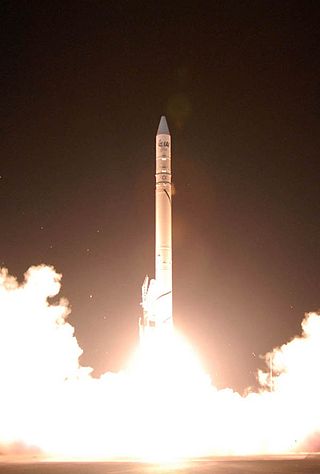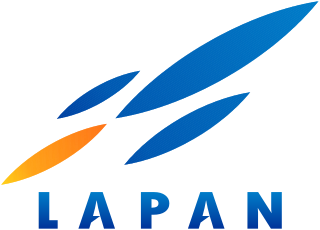
The John F. Kennedy Space Center, located on Merritt Island, Florida, is one of the National Aeronautics and Space Administration's (NASA) ten field centers. Since December 1968, KSC has been NASA's primary launch center of human spaceflight. Launch operations for the Apollo, Skylab and Space Shuttle programs were carried out from Kennedy Space Center Launch Complex 39 and managed by KSC. Located on the east coast of Florida, KSC is adjacent to Cape Canaveral Space Force Station (CCSFS). The management of the two entities work very closely together, share resources and operate facilities on each other's property.

Spaceflight is an application of astronautics to fly spacecraft into or through outer space, either with or without humans on board. Most spaceflight is uncrewed and conducted mainly with spacecraft such as satellites in orbit around Earth, but also includes space probes for flights beyond Earth orbit. Such spaceflight operates either by telerobotic or autonomous control. The more complex human spaceflight has been pursued soon after the first orbital satellites and has reached the Moon and permanent human presence in space around Earth, particularly with the use of space stations. Human spaceflight programs include the Soyuz, Shenzhou, the past Apollo Moon landing and the Space Shuttle programs, with currently the International Space Station as the main destination of human spaceflight missions while China's Tiangong Space Station is under construction.

A spaceport or cosmodrome is a site for launching or receiving spacecraft, by analogy to a seaport for ships or an airport for aircraft. The word spaceport, and even more so cosmodrome, has traditionally been used for sites capable of launching spacecraft into orbit around Earth or on interplanetary trajectories. However, rocket launch sites for purely sub-orbital flights are sometimes called spaceports, as in recent years new and proposed sites for suborbital human flights have been frequently referred to or named "spaceports". Space stations and proposed future bases on the Moon are sometimes called spaceports, in particular if intended as a base for further journeys.

A sounding rocket or rocketsonde, sometimes called a research rocket or a suborbital rocket, is an instrument-carrying rocket designed to take measurements and perform scientific experiments during its sub-orbital flight. The rockets are used to launch instruments from 48 to 145 km above the surface of the Earth, the altitude generally between weather balloons and satellites; the maximum altitude for balloons is about 40 km and the minimum for satellites is approximately 121 km. Certain sounding rockets have an apogee between 1,000 and 1,500 km, such as the Black Brant X and XII, which is the maximum apogee of their class. Sounding rockets often use military surplus rocket motors. NASA routinely flies the Terrier Mk 70 boosted Improved Orion, lifting 270–450-kg (600–1,000-pound) payloads into the exoatmospheric region between 97 and 201 km.

Cape Canaveral Space Force Station (CCSFS) is an installation of the United States Space Force's Space Launch Delta 45, located on Cape Canaveral in Brevard County, Florida.

Shavit 2 is a small lift launch vehicle produced by Israel from 1982 onwards, to launch satellites into low Earth orbit. It was first launched on 19 September 1988, making Israel the eighth nation to have an orbital launch capability after the USSR, United States, France, Japan, People's Republic of China, United Kingdom, and India.

S-Series is a fleet of sounding rockets funded by the Japan Aerospace Exploration Agency (JAXA) that have been in service since the late 1960s. Manufactured by IHI Aerospace and operated by the Institute of Space and Astronautical Science (ISAS). The nomenclature of the S-Series rockets is the number of "S"s indicates the number of stages, and the following number details the diameter of the craft in millimeters. For example, the S-310 is a single stage rocket with a diameter of 310 mm.
Institute of Space and Astronautical Science, or ISAS, is a Japanese national research organization of astrophysics using rockets, astronomical satellites and interplanetary probes which played a major role in Japan's space development. Since 2003, it is a division of Japan Aerospace Exploration Agency (JAXA).

Space Launch Complex 3 (SLC-3) is a launch site at Vandenberg Space Force Base that consists of two separate launch pads. SLC-3E (East) is currently used by the Atlas V launch vehicle, while SLC-3W (West) has been demolished.
Satish Dhawan Space Centre - SDSC is a rocket launch centre (spaceport) operated by Indian Space Research Organisation (ISRO). It is located in Sriharikota, Tirupati district of Andhra Pradesh. Sriharikota Range was renamed in 2002 after ISRO's former chairman Satish Dhawan.

Space Launch Complex 6 at Vandenberg Space Force Base in California is a launch pad and support area. The site was originally developed for Titan III rockets and the Manned Orbiting Laboratory, but these were cancelled before construction of SLC-6 was complete. The complex was later rebuilt to serve as the west coast launch site for the Space Shuttle, but went unused due to budget, safety and political considerations. The pad was subsequently used for several Athena rocket launches before being modified to support the Delta IV launch vehicle family, which used the pad since 2006. The pad is now vacant after the launch of NROL-91 on September 24, 2022, and no future launches are planned.

The National Institute of Aeronautics and Space was the Indonesian government's space agency. It was established on 27 November 1963, by former Indonesian president Sukarno, after one year's existence of a previous, informal space agency organization. LAPAN is responsible for long-term civilian and military aerospace research.

Spaceflight began in the 20th century following theoretical and practical breakthroughs by Konstantin Tsiolkovsky, Robert H. Goddard, and Hermann Oberth. First successful large-scale rocket programs were initiated in the 1920s Germany by Fritz von Opel and Max Valier, and eventually in Nazi Germany by Wernher von Braun. The Soviet Union took the lead in the post-war Space Race, launching the first satellite, the first man and the first woman into orbit. The United States caught up with, and then passed, their Soviet rivals during the mid-1960s, landing the first men on the Moon in 1969. In the same period, France, the United Kingdom, Japan and China were concurrently developing more limited launch capabilities.
Lapan- TUBSat is Indonesia’s first remote sensing satellite, made by the experts from National Institute of Aeronautics and Space and Technical University Berlin (TUB) Germany. The uses of the satellite are for Indonesian natural resources observation and weather forecast for the Indonesian area. Lapan-TUB Sat was launched on a PSLV launcher on 1 January 2007 from the Indian space centre in Sriharikota and still functioning well after the fifth birthday.
Satellite Orbiting Rocket Number 420, or Pengorbitan-1, was a proposed space launch vehicle under consideration in Indonesia from 2008 to 2012. Recent developments have focused on a larger core stage called RX-420 and a smaller upper stage called RX-320, so this particular version RPS-420 is not being pursued any longer. However the goal remains valid: Indonesia aims to reach orbit with self-made rockets and satellites in order to become an Asian space power.
Kartika I is an Indonesian sounding rocket built by LAPAN, AURI, Bandung Institute of Technology, and Pindad under PRIMA project. This rocket was launched on August 14, 1964, in LAPAN Rocket Launching Station Pameungpeuk, West Java, becoming the first sounding rocket ever launched in Indonesia, and the third in Asia after Japan through Kappa Rocket and Pakistan with the Rehbar series.
The RX rocket family is a series of solid-fuel rockets developed by the Indonesian National Institute of Aeronautics and Space (LAPAN). They are simply named by their diameter in millimeters; for example, the RX-250 has a diameter of 250 millimeters (9.8 in).

The following is a timeline of important events in the history of private spaceflight, including important technical as well as legislative and political advances. Though the industry has its origins in the early 1960s, soon after the beginning of the Space Age, private companies did not begin conducting launches into space until the 1980s, and it was not until the 21st century that multiple companies began privately developing and operating launch vehicles and spacecraft in earnest.

JCSAT-16 is a geostationary communications satellite operated by SKY Perfect JSAT Group and designed and manufactured by SSL on the SSL 1300 platform. It has a launch weight of 4,600 kg (10,100 lb), a power production capacity of 8.5 kW and a 15-year design life. Its payload is composed of Ku band and Ka band transponders. SKY Perfect JSAT Group plans to use JCSAT-16 as an in-orbit backup satellite for the Ku- and Ka-band satellites serving the Japanese market.

Telkom 4, also known as Merah Putih, is an Indonesian geostationary communication satellite built by Space Systems/Loral that is located at an orbital position of 108° East and is operated by PT Telekomunikasi Indonesia Tbk. The satellite is based on the SSL 1300 satellite bus and has a life expectancy of 16 years. It was launched on 7 August 2018, at 05:18 UTC or 12:18 Jakarta Time, using the SpaceX Falcon 9 Block 5 launcher from Cape Canaveral Air Force Station, Florida, United States.















